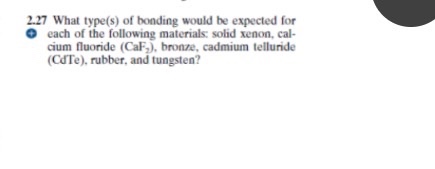What Type S Of Bonding Would Be Expected For Rubber

Materials science and engineering 9th edition edit edition.
What type s of bonding would be expected for rubber. A ionic bonding b metallic bonding c covalent bonding with some van der waals bonding d van der waals bonding solution the correct answer is c. Between a metallic and non metallic element the bond will be different than it would be between two metals and two non metals. What type s of bonding would be expected for each of the following materials. 2 4fe what type s of bonding would be expected for rubber.
Also upon this same tangent the bond between two atoms of the same element will be a different type of bond than that which. Surfaces may have mold release slip additives or other processing lubricants on them so a quick wipe with isopropanol is a good idea. Solid xenon calcium fluoride caf2 bronze cadmium telluride cdte rubber and tungsten. What type s of bonding would be expected for each of the following materials.
Ionic bonding metallic bonding covalent bonding with some van der waals bond van der waals bonding. What type s of bonding would be expected for each of the following materials. I would look up covalent and ionic bonding. Brass a copper zinc alloy rubber barium sulfide bas solid xenon.
Before attempting rubber bonding it is advisable to carry out a solvent degrease. Acetone may be too aggressive as certain types of rubber are vulnerable to attack. For rubber the bonding is covalent with some van der waals bonding. What type s of bonding would be expected for rubber a ion.
Problem 4feqp from chapter 2. Rubber barium sulfide solid xenon bronze nylon and aluminium phosphate. Question asked jul 25 2020. What type s of bonding would be expected for rubber.
Aluminum phosphide alp all chemistry practice problems ionic and covalent bonds practice problems. What type s of bonding would be expected for each of the following materials.













































